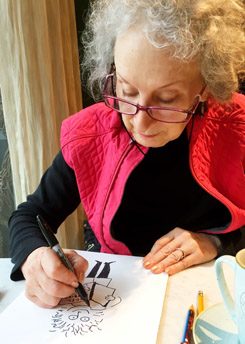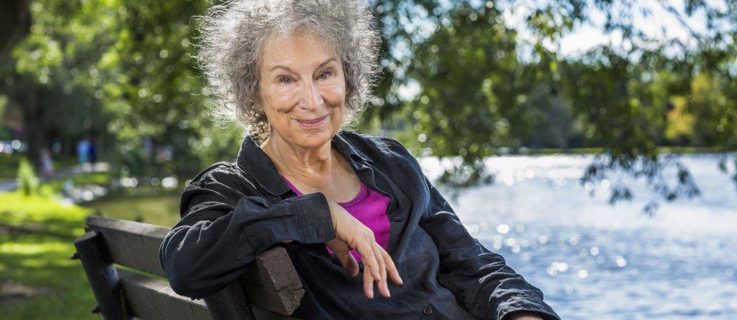Author Margaret Atwood on dystopian literature classics becoming topical again in times of Trump, her new novel and excursions to the comics world.
By Lars von Törne
Mrs. Atwood, "The Handmaid’s Tale" from 1985 tells how the U.S. turns into a Christian- fundamentalist dictatorship. The book is now back on the bestseller-lists, together with George Orwell’s "1984" and Aldous Huxley’s "Brave New World". Are bad times beneficial for dystopian novels?
They always have been. Imagining the worst is a way to prepare for it. People who read such books won’t be completely surprised by certain developments. Donald Trump is not the only one we have to keep an eye on, though. Trump on his own is not a religious, right-leaning fundamentalist. During the election, it had been a problem for the religious fundamentalists that he was not one of them. In the end they were able to promote him following the diction “God moves in mysterious ways”. He grants them things they have wanted for a long time, such as the prohibition of abortion and the withdrawal of previous transgender politics.
Does that mean that you were not surprised by Trump’s actions over the last few months?
I have seen a lot during my life. I was born in 1939; Hitler, Stalin, Mao, Pol Pot and the genocide in Rwanda. All that happened and will continue happening. No society is immune to that. It is important to interpret correctly the early signs. For example what happened in Arizona not long ago. Republican senators passed a bill that would allow the state to confiscate protestors’ possessions if their demonstration becomes violent. This compromises the freedom of assembly.
At the Women’s March in Washington people were holding signs like “Make Margaret Atwood Fiction Again“ and “'The Handmaid’s Tale' was not an instruction manual”. What did you feel when you saw that?
I participated in one of these marches here in Toronto. My favorite sign was by a woman in her 70s: “After 60 years I am still holding the same fucking sign”. That’s how it is: everything is circular. The election has awoken those who had previously been apolitical. Now they see that things are at stake. This has been a wake-up call. We have to see how much damage the new government will cause. Beginning with environmental protection and climate policies which will have extensive consequences: the more global warming there is, the more extreme the weather will be and the more difficult it will be to feed the world’s population. This will lead to more conflicts in distribution and more civil wars will occur. It’s always women who will suffer the most because of that.
.
"The Handmaid’s Tale" is currently filmed as a TV-series, it is the second adaptation after Volker Schlöndorff made a film in 1990.
I attended the premiere in Berlin back then. The Berlin Wall had just fallen and the film drew different reactions between East and West Berlin. In the west, people mainly discussed aesthetical matters, whereas in the east many said, “This was our life.” And they didn’t mean the costumes or the religious parts of the story but the repression and the feeling that they couldn’t speak freely because the Stasi (the GDR’s intelligence agency and secret police) was always listening.
Your new novel, "The Heart Goes Last", can be read as commentary on the present as well. It is set at a time where wars over the remaining resources have turned the U.S. into a desert. Violence and anarchy prevail and the protagonists subordinate willingly to a profit-oriented prison that acts like a business.
Under certain circumstances, people act like that. They would prefer a strong leader who promises them law and order and give up some of their fundamental rights than live in anarchic conditions where they have to fight for their lives. My two protagonists live in a car without any security provided by the state. Under those conditions it is a huge temptation to trade freedom for assumed security. You and I would probably do the same.
Your book combines elements of science-fiction, thriller, romantic drama and comedy but above all, it reads like an appeal to defend fundamental rights.
My message is that we have to find solutions for unemployment, poverty and the breakdown of social cohesion. We need a state-subsidized social net of benefits. This is exactly what is rejected by right-leaning Evangelical fundamentalists in the U.S. because they want to draw in desperate people to their church.
You began working on the book five years ago – yet it sounds quite a bit like commentary on Trump’s America.
A lot was conceivable back then. The privatization of the prison system, for example, is structured in a way that companies only earn a profit if the prisons are full. Thus, new criminals are constantly being produced. There are places in the U.S. where the prison is the only notable employer.
 Not only a novelist: Margaret Atwood is also a comic author.
| © Lars von Törne
Other than your novels you have written a comic trilogy that has gained a lot of attention in the U.S. and Canada. The main character is a human who, after an accident, becomes a bird who also happens to be a cat and a human: "Angel Catbird". Incidentally, one can learn a lot about the protection of birds and cats. How did this change to comics come about?
Not only a novelist: Margaret Atwood is also a comic author.
| © Lars von Törne
Other than your novels you have written a comic trilogy that has gained a lot of attention in the U.S. and Canada. The main character is a human who, after an accident, becomes a bird who also happens to be a cat and a human: "Angel Catbird". Incidentally, one can learn a lot about the protection of birds and cats. How did this change to comics come about?
Both birds and cats are dear to me. Both are endangered. I wondered how this topic can be approached and how cat owners can be made aware of the fact that their pets are a huge threat to birds living in the wild. I invented a superhero who is part cat, part bird and can see both sides of the problem to show how both species can be better protected.
Why is a comic better to portray that than a novel?
Had I written a novel about a flying cat-bird-human it most likely would have been quite an absurd-surrealistic story. It would have been the wrong medium. Things like that work better in a comic. Especially because I want to reach families; I want to persuade them to look into their cats’ behavior and better protect birds. Ten-year-old kids are very often the driving force behind the purchase of cats, so I had to find a format that appealed to both ten-year-olds and adults.
When reading your comic, one gets the impression that you had a lot of fun letting your inner nerd-girl out.
I have been reading comics since childhood. At the beginning, I read comics in newspapers, later I became a huge fan of Asterix whose puns I love, and of Claire Bretecher’s comics. Also, I draw short comic strips myself to deal with everyday experiences. I have been doing this since childhood, and I drew some new ones recently.
How did your readers react to your superhero-comic-world?
Some said, “Oh Margaret, you have become crazy.” But I also hear very often, “My children love your book.” as often as, “My wife loves your book.”
As a writer you can control every aspect of your work. A comic like "Angel Catbird" is teamwork, though. You are the writer with an illustrator, a colourist and an editor involved in the process. Is it easy to give up control?
Yes, my whole life I have been working on projects with other people. As a student I founded a puppet theatre with my friends. We performed "Little Red Riding Hood" and "Hansel and Gretel" at children’s birthday parties and earned some money. And in high school we brought the world’s first opera about Home Ec on stage.

